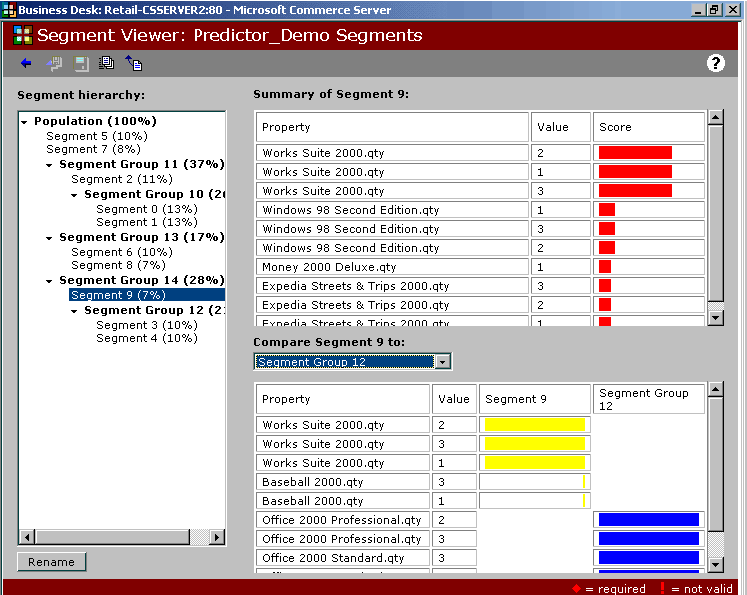
Click the illustration to enlarge or reduce.
You use the Segment Viewer module to perform segmentation (or clustering) analysis. In segmentation analysis, users are grouped into
You use the Segment Viewer module to examine a single segment or to compare one segment to another. You also use the Segment Viewer module to create a summary report of all your segments.
Segments are clusters of users that exhibit similar behavior on the site or have similar properties such as age and gender. A segment consists of a summary of the database records that belong to it. The summary is derived from properties in the Data Warehouse used to cluster the database records. Segment groups are collections of similar segments or other segment groups. Similar segments and segment groups are then merged to form higher-level segment groups. This process continues until a single, high-level segment group is formed representing the entire population.
The Segment Viewer presents the segments in hierarchical order, with the top-level segment group summarizing the entire population and the lower-level segment groups and segments summarizing smaller and smaller subsets of the population. You use the information gathered in the Segment Viewer as the basis for
The segment groups form a hierarchy from which you can analyze trends and discover correlations within the data at different levels of the
A Segment model describes the characteristics of the users belonging to each of the segments and segment groups. You use Segment models to discover and analyze the attribute values that characterize the users visiting your site. For example, after building a Segment model, you may discover a segment characterizing users who purchased a popular fantasy book for children: female, over 40, income above $55,000 per year, and an education level of college graduate or greater. After you have discovered these common characteristics, you can then offer similar products to users matching those criteria. For example, these users may also be likely to buy an animal book for children.
At your request, your system administrator can build Segment models using data derived from the Commerce Server
You view segment groups and single segments using the Segment Viewer, a data analysis tool designed for the business manager. Using the Segment Viewer module, you can identify usage trends and make marketing decisions based upon similarities among users.
You use the Segment Viewer module to view relevant information about various segments and to compare and contrast their properties. You can save members of single segments to a list in the List Manager module if you want to perform further analysis and classification on the segments.
When you first open the Segment Viewer module, a list of available Segment models appears. After you select a Segment model and click the Open Model button on the toolbar, the Segment Viewer screen appears. Three work areas appear on this screen:
The first time you view a Segment model using the Segment Viewer, the segments and segment groups in the segment list have generic names, such as Segment1, Segment2, and so on. The percentage of the total population represented in a segment or segment group appears in parentheses after the name. The segment summary appears in the screen to the right of the segment list.

Click the illustration to enlarge or reduce.
The summary of your segment or segment group contains a table with the following columns:
You can use the Segment Viewer to generate a report that is a summary of all the segment groups and segments you have created. You use this report to compare all segments. Each segment and segment group has links to its detailed information; clicking on these links allows you to move easily between segments. The report appears in a separate browser window.
Exporting Segment Data to List Manager